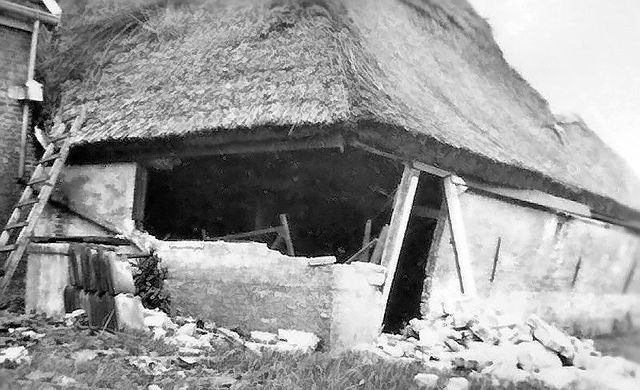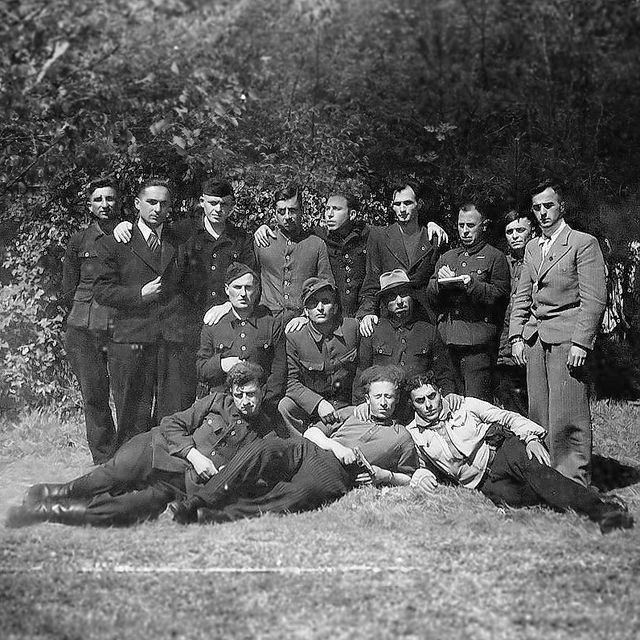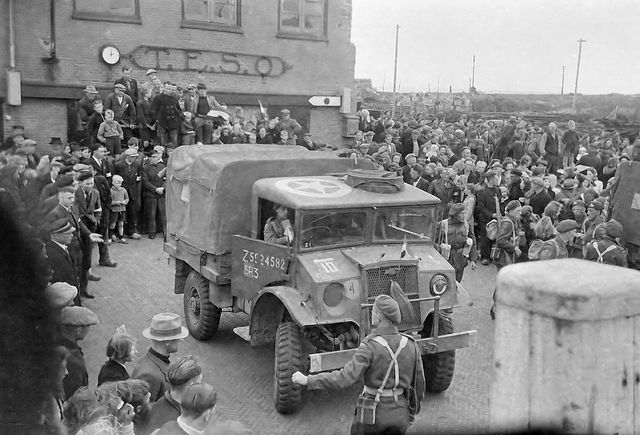Reading time: less than 8 minutes
Together with Den Helder, Texel became involved in the German attack on the Netherlands at an early stage. This was due to the island's unique position in the Wadden area, adjacent to Den Helder on the Marsdiep, Texel was part of Stelling Den Helder.
Texel was first bombed on 10 June 1940. Two Messerschmitts attacked De Vlijt airport. A second attack followed later that day and then again on 11 May. De Mok, an airfield for seaplanes, was attacked on 11, 12, 13 and 14 May. The Luftwaffe succeeded in putting many Dutch aeroplanes and seaplanes out of commission.
Texel also had anti-aircraft artillery. The Dutch army had 2 coastal batteries for the mobilisation. In those days, a total of 1,500 Dutch military men from the land forces, navy and air force were stationed on the island. But despite shooting down several German planes, the Dutch land forces were not very effective. Den Helder and Texel were the exceptions. De Kooy, Bergen, Valkenburg, Ypenburg and Ockenburg airports were surprised by the German attacks and were only able to deploy a few planes.
On 14 May 1940, the Germans bombed 'De Mok’ naval airbase. Not much remained.

After the Dutch army surrendered, the Germans set foot on Texel on 19 May. The first German troops were navy units. Land and air forces soon followed. The German army took over the Dutch batteries and quickly began building bunkers as part of the Atlantic Wall.
In the first two years of the war, the Germans built the so-called Küverbunkers, coastal defence bunkers. They had thin walls but were shrapnel resistant. Coastal batteries were constructed on the north side (Eierland) and the south side (de Hors) of the island. The Germans set up 2 anti-aircraft batteries at De Mok and Den Hoorn to protect Den Helder's airspace.
With the programmes for the Neue Westwall and later the Atlantic Wall, the German army provided cement bunkers for the most important positions on Texel, the coastal batteries and the airport command post, which were much sturdier than the thin-walled Küverbunkers. An important communication bunker arose at Den Burg, the Texla bunker.
Men from the German air force pose on dismantled naval mines that washed up on the beach of Texel.

German anti-aircraft and fighter planes shot down many allied aircraft on or near Texel. The fighter planes took off from the airport in Leeuwarden and De Kooy near Den Helder and anti-aircraft artillery came from the batteries on Texel. 19 planes crashed on the island. Commemorative stones around the island mark these sites. Attacks by German fighter planes caused around 30 more planes to disappear in the North Sea and the Wadden Sea.
And the famous Messerschmitts started their hunt for allied aircraft from Texel airport De Vlijt. On 11 May 1940, they shot down a Fokker D-XVII that went up in flames. On 21 June 1940, two English planes on their way to Den Helder from Texel were shot down. Most of the crew were killed and were buried on Texel. On 29 July, an English plane made an emergency landing near the De Witte Hoek farm from the De Waard family on Texel. The gunner was killed, and the pilot and scout taken prisoner. A total of 50 aeroplanes crashed on or near Texel, says Bram van Dijk.
Naval airbase De Mok
The naval port and airbases in Den Helder and on Texel suffered greatly under the German attacks. On 14 May, the commander of De Mok realised the situation was unsustainable and decided to blow up the naval airbase. The crew stayed at hotel de Lindeboom where a few of the young airmen made plans to escape to England. They needed a leader that was 'as tough as nails'. That was Koos Weber, born in Rotterdam and stationed in De Kooy near Den Helder and De Mok on Texel during the mobilisation. Koos Weber picked up the gauntlet and, after an adventurous journey, the men reached the English coast. In London, they continued their fight against the occupiers. Weber clocked up an impressive amount of flying hours from England. On 30 August 1941, his plane was shot down. His body was never found.
Because Texel had an airport where the German fighters could operate from, Allied Forces bombed the island 215 times. Most bombs were dropped by planes that prematurely aborted their mission to bomb German cities. To be registered as an operational flight, the bombs were dropped above Texel, often without there being any clear target. On 29 March 1943, the Luftwaffe closed down De Vlijt airport.
Texel had to deal with many allied bombings during the war. On the night of 3 July 1942, Willem Johan Jacobszoon Boersen's (1905-1976) farm was heavily damaged by bombs from, most likely, an English plane.

Due to the location of the Marsdiep, Texel was of great strategic importance for naval port Den Helder. Access to Den Helder could be defended from Loodsmansduin and the South-Battery. This explains why there were so many German troops on the island during the war. German convoys passing by during the day profited from the relative safety of the Marsdiep.
Many were taken as prisoners of war during the advance of the German armies in Russia and forced to live in camps under appalling conditions. To escape the misery, many Russians volunteered for German service when German army officers began recruiting prisoners of war. This led to the creation of around 50 'East battalions' that were deployed to the Western Front and often manned parts of the Atlantic Wall.
‘Day of birth’
On 6 February 1945, a Georgian battalion of 756 men relieved a Caucasian battalion. The Georgians had been stationed in Zandvoort and their contacts in the resistance kept them well informed about the war. The invasion of the allied troops meant two things for them: be used to fight against the allied troops in the Eastern Netherlands and the fear of retaliations if they return to Russia after the war. Because neither of these scenarios was appealing, plans were made to rise against the German troops on Texel, thus erasing this blemish. Their operation went into the history books as the ‘Dag der Geboorte’ (Day of Birth).
Georgians who survived the uprising on Texel await their fate.

On 5 April, the Georgian battalion commander, Sjalwa Loladze, receives orders from the Germans to get the troops ready to go to the front in the Eastern Netherlands. That was the moment to act. During the night of 5 to 6 April, the Georgians killed hundreds of Germans in their sleep. It was a quiet and horrific massacre carried out with knives and daggers. When the Georgians had control over two-thirds of the island, shots were heard and the Germans began a counteroffensive.
Bloody battle
The Georgians had tried to get the underground organisation on Texel involved in the uprising, but there was not much interest. Nevertheless, the Germans arrested 14 random Texel residents who they suspected of supporting the Georgians and they were brought to De Mok in a lorry. 4 men escaped on the way and 10 men were executed on arrival. A bloody battle ensued on Texel the following days. The vibrant memories are proof of the immense suffering and devastation on Poldereiland.
Georgian uprising costs the lives of 117 Texelaars
Slowly but surely, the Germans were able to push back the Georgians. Prisoners were executed immediately. The stronghold around the Eierland lighthouse held out for a long time, but this bunker too was conquered on 20 April 1945. This caused a guerrilla-like war in which many farms were set on fire. Den Burg, De Waal and De Koog were severely damaged. A total of 117 Texelaars lost their lives in these battles, whereas up until April 1945 almost no residents had been killed. Theo Witte lost his brother Henk during the Georgian uprising, he tells us here.
The Texelaars experienced the after-effects of the uprising with mixed emotions. Some saw the rebels as heroes while others considered them to be traitors and assassins. The Georgian battalion was also the only East battalion whose survivors were not sent to punishment camps when they returned to Russia.
Read more about the Georgian uprising here →
On 20 May, the 1st Canadian army corps arrived on Texel. On 21 May, the Germans were brought to Den Helder where they then left for Wilhelmshaven. The island was left behind in shock. Shortly before the liberation ended the war, 117 Texel residents lost their lives. Due to the massacre, the liberation was hardly even celebrated on Texel. 'It was not a celebration at all', say witnesses.
More than 600 Germans and 565 Georgians stationed on the island did not survive the war. 467 Georgians were buried in the Hoge Berg where the cemetery was named after their commander, Loladze. The first monument for the Georgians was erected on 15 June 1945 but was desecrated by unknown vandals shortly afterwards. The 236 Georgians who survived the uprising left on a ship from Oudeschild to Wilhelmshaven on 17 June 1945.
On 20 May 1945, the Canadians arrive on Texel on the Dr. Wagemaker’ ferry from TESO.

With more than 500 buildings, including 3 coastal batteries and 2 anti-aircraft batteries, Texel was a strong support point for the German occupiers.
The War and Aviation Museum has set out various routes along the remains of the Atlantic Wall on Texel. The museum is working hard to make some of the bunkers accessible again, including the South-Battery's outlook post on the Loodsmansduin on the southernmost point of the island and several bunkers close to the museum.
Visit Texel